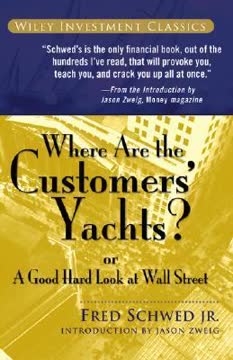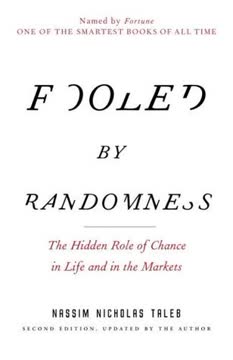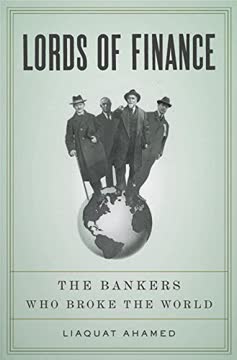Key Takeaways
1. The 1920s Boom Was Fueled by Speculative Mania, Not Just Prosperity
Along with the sterling qualities he praised, they were also displaying an inordinate desire to get rich quickly with a minimum of physical effort.
A time of prosperity. While President Coolidge lauded the tranquility and prosperity of the late 1920s, beneath the surface of rising production and employment lay a growing public obsession with effortless wealth. This mood was not solely based on the solid economic growth occurring, but on a fervent belief in unlimited rewards from speculation. The Florida real estate boom served as an early, dramatic example of this speculative fever, where land values soared based purely on the expectation of future price increases, detached from any intrinsic use or income.
Florida's speculative bubble. The Florida boom demonstrated the classic elements of a speculative mania: an indispensable element of substance (climate) upon which a world of make-believe was built. Buyers sought not to use the land but to flip it for a quick profit, fueled by easy credit (10% down payments) and a constant influx of new buyers. The collapse in 1926, hastened by hurricanes, was widely known, yet the speculative mood remarkably survived, shifting its focus to the stock market.
Stock market takes over. Beginning in 1924, stock prices rose steadily, initially reflecting good corporate earnings. However, by 1928, the market entered a phase of "mass escape into make-believe," characterized by vaulting leaps in prices and a diminishing focus on underlying value. This period saw the rise of "big professional traders" and a growing public conviction that the market was a guaranteed path to riches, detached from traditional investment principles.
2. Authorities Knew Speculation Was Dangerous but Were Paralyzed by Fear of Intervention
The consequences of successful action seemed almost as terrible as the consequences of inaction, and they could be more horrible for those who took the action.
Awareness of the bubble. By early 1929, those in positions of authority, including some at the Federal Reserve and even President Hoover (privately), recognized that a wild speculation was underway and would inevitably end. However, they faced a profound dilemma: intervening to stop the boom would cause an immediate collapse, for which they would be blamed, while inaction risked a more severe disaster later. The latter option offered the comfort of delaying the inevitable blame.
Limited tools and will. The Federal Reserve's traditional tools—open market operations and the rediscount rate—were seen as largely ineffective or too blunt. Selling government securities was limited by inventory, and raising interest rates would hurt "legitimate" business more than speculators who were making huge gains. Furthermore, a significant portion of market funding came from corporations and individuals, over which the Fed felt it had no control. The most powerful tool, a strong public denunciation, was avoided due to fear of causing a sudden, attributable crash.
Moral suasion fails. The Fed's timid attempts at "moral suasion," such as the vague warning in February 1929, only caused temporary checks in the market, proving its underlying nervousness but not stopping the rise. Charles E. Mitchell of National City Bank openly defied the Fed, pledging bank funds to the call market to prevent a money squeeze, effectively asserting Wall Street's priority over the Fed's concerns. This episode highlighted the Fed's impotence or unwillingness to act decisively, leaving the market free to soar.
3. Investment Trusts Became the Ultimate Engine of Speculative Excess
The virtue of the investment trust was that it brought about an almost complete divorce of the volume of corporate securities outstanding from the volume of corporate assets in existence.
Meeting demand for stocks. As the public clamored for stocks, the supply was augmented not just by new corporate issues but significantly by investment trusts. These entities didn't create new real assets but issued their own securities to buy existing stocks, effectively creating layers of paper claims on underlying assets. This invention perfectly suited the time, allowing the volume of securities to expand far beyond the growth of the real economy.
Profitable sponsorship. Organizing investment trusts was immensely profitable for sponsoring firms (banks, brokers, other trusts). They earned management fees and, crucially, received allotments of stock or warrants at the offering price, which could immediately be sold to the eager public at a substantial premium. This incentive structure fueled a rapid proliferation of trusts, with hundreds formed in 1928 and 1929, marketing billions in securities.
Leverage and pyramiding. The concept of leverage, achieved by issuing bonds and preferred stock alongside common stock to buy common stocks, became central. Rising portfolio values were geometrically amplified on the common stock of the trust. This led to pyramiding, where one trust sponsored another, which sponsored another, concentrating control and magnifying gains (and later losses) through chains of inter-company holdings. Goldman, Sachs' Shenandoah and Blue Ridge trusts were prime examples of this "gargantuan insanity."
4. Optimism and Denial Reigned Until the Inevitable Collapse Began
All people are most credulous when they are most happy.
Market's relentless rise. The summer of 1929 saw the market continue its astonishing ascent, with major averages gaining nearly a quarter in just three months. Trading volume remained high, and brokers' loans, fueled by corporate and individual funds seeking high interest rates, soared past seven billion dollars. Despite these signs of excess, the prevailing mood was one of boundless optimism and a firm belief in the permanence of the "New Era" prosperity.
Prophets of confidence. A chorus of voices, including prominent bankers, economists, and public figures, offered constant reassurance. Charles E. Mitchell declared conditions "fundamentally sound," while Professor Irving Fisher famously proclaimed a "permanently high plateau." The Harvard Economic Society, after a brief bearish phase, capitulated to the prevailing optimism. Pessimists were dismissed or even accused of sabotage, highlighting the strong desire to believe that the market's rise was justified and sustainable.
Ignoring the warning signs. Even as the market showed increasing volatility and some economic indicators began to turn down in the summer, the dominant narrative remained positive. The exposure of the Hatry fraud in London and a Massachusetts regulator's refusal to allow a stock split were minor tremors largely dismissed. The market had become central to the culture, dominating news and conversation, with many new, less sophisticated participants relying on the perceived genius of financiers or simply the momentum of rising prices.
5. The Crash Was a Terrifying Cascade of Panic Selling and Margin Calls
Of all the mysteries of the stock exchange there is none so impenetrable as why there should be a buyer for everyone who seeks to sell.
The Babson Break. The first significant jolt came on September 5th, triggered by Roger Babson's prediction of a "terrific" crash. While initially dismissed, this "Babson Break" marked the beginning of an erratic but generally downward trend through September and October. The market's sensitivity to even a dissenting voice revealed its underlying instability, though the speculative fervor, as measured by brokers' loans, continued to increase.
Black Thursday. October 24th, 1929, became the first day etched in history as panic took hold. The market opened quietly but soon devolved into a "wild, mad scramble to sell." Volume soared to nearly 13 million shares, and prices plummeted vertically as selling orders overwhelmed buyers. The ticker lagged hours behind, leaving speculators in terrifying ignorance of their mounting losses. Crowds gathered outside the Exchange, reflecting the widespread fear and confusion.
Margin calls fuel panic. As prices fell, thousands of speculators received margin calls, demanding additional cash collateral to cover the diminished value of their holdings. Unable to meet these demands, many were automatically sold out by their brokers, adding to the torrent of selling and accelerating the price decline. This vicious cycle of falling prices, margin calls, and forced selling was a key mechanism of the crash.
6. Bankers' Attempts at Organized Support Proved Futile Against the Tide
The financial community, the Times said, now felt "secure in the knowledge that the most powerful banks in the country stood ready to prevent a recurrence [of panic]."
The Morgan meeting. On Black Thursday, as panic peaked, a meeting of the nation's most powerful bankers convened at J.P. Morgan & Co. The news alone had a calming effect, evoking memories of J.P. Morgan Sr.'s intervention in the 1907 panic. Thomas Lamont of Morgan's downplayed the crisis publicly, and Richard Whitney, acting president of the Exchange and known as Morgan's floor trader, dramatically placed large buying orders for key stocks like U.S. Steel.
Temporary rally. Whitney's actions and the news of the bankers' pool sparked an immediate, electric rally. Prices rebounded sharply from their lows, checking the chain reaction of stop-loss orders and forced selling. The recovery on Black Thursday was remarkable, leading many to believe the worst was over and that the bankers had successfully demonstrated their power to stabilize the market.
Support collapses. However, the respite was brief. On Monday, October 28th, the market suffered even more severe losses than on Thursday, and this time, the organized support did not materialize effectively. The bankers' subsequent statement clarified their goal was merely an "orderly market," not maintaining prices or protecting profits. By Black Tuesday, October 29th, with a record 16.4 million shares traded and prices collapsing across the board, it was clear that the bankers' power was no match for the overwhelming desire to sell. Their prestige plummeted as rapidly as the market.
7. The Aftermath Revealed Financial Dishonesty and Exposed Systemic Weaknesses
To the economist embezzlement is the most interesting of crimes.
Suicide myth vs. reality. Contrary to popular legend, the stock market crash did not cause a sudden surge in suicides. While the suicide rate had been rising and continued to increase in the following depression years, the immediate months after the crash showed no significant spike. The myth likely arose from attributing existing suicides to market losses or from later depression-era tragedies being anachronistically linked to the crash.
The "bezzle" exposed. The crash did, however, dramatically accelerate the discovery of embezzlement. In good times, lax oversight and abundant money allow the "bezzle"—the inventory of undiscovered embezzlement—to grow. The sudden financial distress and increased scrutiny following the crash led to a wave of confessions and exposures, from small-time employees who gambled with company funds to spectacular cases like the looting of the Union Industrial Bank of Flint, Michigan, whose officers had lost millions speculating.
Banker misconduct revealed. Later investigations, particularly by the Pecora Committee, exposed astonishing practices by the heads of major banks like Chase and National City. Albert H. Wiggin of Chase engaged in extensive personal speculation, including shorting his own bank's stock through Canadian holding companies, financed by the bank itself. Charles E. Mitchell of National City, a vocal proponent of the New Era, was later indicted (though acquitted) for tax evasion related to selling stock to his wife to establish a loss, revealing the lengths to which even prominent figures went to manage their finances amidst the collapse.
8. Hoover's Reassurances Were Ritualistic, Not Effective Economic Policy
Mr. Hoover in 1929 was a pioneer in this field of public administration.
Initial limited action. Following the crash, President Hoover took some steps, including a modest tax cut, which, while in the right direction, had negligible impact due to the low tax base for most Americans. He also convened a series of high-profile meetings with leaders from industry, labor, and agriculture.
The "no-business" meetings. These White House conferences were less about formulating concrete policy and more about creating the impression of action. Attended by important figures, they generated optimistic press statements but resulted in few binding commitments. This ritualistic approach, simulating action without undertaking significant government intervention, became a hallmark of Hoover's response to the unfolding crisis.
Continued optimism despite decline. Despite the clear and rapid deterioration of economic indicators—falling production, carloadings, and commodity prices—Hoover and his administration continued to issue optimistic forecasts. These repeated, unfounded assurances, while perhaps intended to restore confidence, became increasingly detached from reality and contributed to a sense of official denial as the depression deepened.
9. The Great Depression Was Exacerbated by Fundamental Economic Flaws Exposed by the Crash
There seems little question that in 1929, modifying a famous cliché, the economy was fundamentally unsound.
Underlying weaknesses. While the crash triggered the severe downturn, the economy was built on fragile foundations that magnified the shock. Five key weaknesses contributed:
- Bad income distribution: Wealth concentrated at the top meant demand relied heavily on volatile luxury spending and investment.
- Bad corporate structure: Pyramidal holding companies and investment trusts were vulnerable to reverse leverage, forcing retrenchment.
- Bad banking structure: Numerous independent banks meant failures spread contagiously, freezing assets and destroying confidence.
- Dubious foreign balance: Dependence on foreign lending to cover trade deficits ended abruptly, forcing export cuts.
- Poor economic intelligence: Prevailing dogma favored balanced budgets and monetary restraint, preventing effective counter-deflationary policy.
Crash as an accelerant. The stock market collapse acted as a powerful catalyst, exploiting these weaknesses. It directly hit the spending and investment of the wealthy, destroyed the fragile corporate pyramids, triggered bank runs by shattering confidence, and halted the foreign lending that propped up exports.
Policy paralysis. Crucially, when the crisis struck, the dominant economic thinking—fixated on balancing the budget and adhering to the gold standard—prevented any meaningful government intervention to stimulate demand or ease credit. This intellectual straitjacket ensured that the initial downturn spiraled into a decade-long depression.
10. While Reforms Addressed Past Weaknesses, the Propensity for Speculation and Political Paralysis Remain
No one can doubt that the American people remain susceptible to the speculative mood—to the conviction that enterprise can be attended by unlimited rewards in which they, individually, were meant to share.
Post-crash reforms. The trauma of the crash and depression led to significant structural reforms. Income distribution became less unequal, investment trusts were regulated (though new forms emerged), federal deposit insurance stabilized the banking system, and the SEC was created to oversee securities markets and prevent manipulation. Monetary and fiscal policy gained acceptance as tools to manage the economy.
Enduring speculative spirit. Despite these changes and the painful memory of 1929, the American public retains a strong susceptibility to speculative booms. Rising markets still attract participants drawn by the allure of effortless riches.
Political constraints on intervention. While regulators now have tools like margin requirements to curb speculation, their use is often constrained by political considerations. Stopping a boom risks causing a downturn, which is politically unpopular, especially with elections looming. Authorities may hesitate, hoping the boom will continue or subside gently, fearing blame for the inevitable crash if they trigger it.
Risk of recurrence. Although the specific weaknesses of 1929 have been addressed, a future speculative bubble and collapse could still pose risks. New vulnerabilities might emerge, and political reluctance to intervene early could allow excesses to build. The cycle of speculative enthusiasm, denial, and delayed, insufficient action remains a potential threat to economic stability.
Last updated:
Review Summary
The Great Crash 1929 is praised for its witty and engaging narrative of the stock market crash. Readers appreciate Galbraith's insights into the causes and consequences of the event, drawing parallels to modern economic crises. The book is commended for its accessible explanations of complex financial concepts, though some find it overly focused on technical details. Critics note that Galbraith's analysis may be outdated and biased towards Keynesian economics. Overall, the book is considered a valuable historical account of a pivotal economic moment.
Similar Books










Download PDF
Download EPUB
.epub digital book format is ideal for reading ebooks on phones, tablets, and e-readers.






